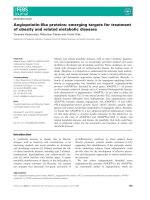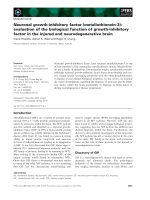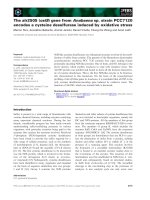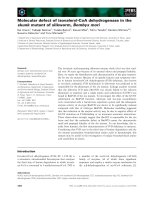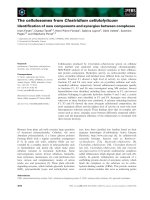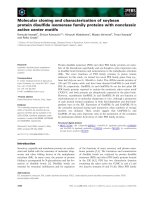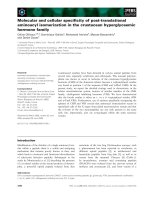Tài liệu Báo cáo khoa học: Molecular cloning, recombinant expression and IgE-binding epitope of x-5 gliadin, a major allergen in wheat-dependent exercise-induced anaphylaxis ppt
Bạn đang xem bản rút gọn của tài liệu. Xem và tải ngay bản đầy đủ của tài liệu tại đây (375.35 KB, 8 trang )
Molecular cloning, recombinant expression and
IgE-binding epitope of x-5 gliadin, a major allergen in
wheat-dependent exercise-induced anaphylaxis
Hiroaki Matsuo, Kunie Kohno and Eishin Morita
Department of Dermatology, Shimane University School of Medicine, Izumo, Japan
Wheat is one of the most widely cultivated staple
foods for western people. Patient with wheat allergy,
especially wheat-dependent exercise-induced anaphy-
laxis (WDEIA) has increased recently, as there is now
a higher consumption of western style food in Japan
[1,2]. WDEIA is a distinct form of wheat allergy in
which the patient experiences a very severe allergic
reaction in response to intense exercise after ingestion
of wheat [3,4]. Our previous study demonstrated that
exercise and aspirin intake facilitate absorption of the
wheat allergens from the gastrointestinal tract in
patients with WDEIA [5]. It follows that the allergens
transferred into circulating blood cross-link receptor-
bound IgE on mast cells and cause degranulation
followed by release of chemical mediators such as his-
tamine. They induce immediate inflammatory reactions
similar to those of common food allergies such as
urticaria, angioedema, hypotension, and shock.
To diagnose WDEIA, we typically perform an exer-
cise challenge test combined with wheat ingestion for
patients who have episodes of anaphylaxis after wheat
intake. However, the challenge test is unsafe for
patients because an anaphylactic shock is sometimes
provoked in the test. An radioallergosorbent test to
wheat protein or wheat gluten is commercially avail-
able for diagnosis of wheat allergy, but this test is not
Keywords
wheat; allergy; gliadin; allergen; recombinant
Correspondence
H. Matsuo, Department of Dermatology,
Shimane University School of Medicine,
89-1 Enya-cho, Izumo, Shimane 693-8501,
Japan
Fax: +81 853 21 8317
Tel: +81 853 20 2210
E-mail:
(Received 30 May 2005, accepted 12 July
2005)
doi:10.1111/j.1742-4658.2005.04858.x
Wheat x-5 gliadin has been identified as a major allergen in wheat-depend-
ent exercise-induced anaphylaxis. We have detected seven IgE-binding
epitopes in primary sequence of the protein. We newly identified four
additional IgE-binding epitope sequences, QQFHQQQ, QSPEQQQ,
YQQYPQQ and QQPPQQ, in three patients with wheat-dependent exer-
cise-induced anaphylaxis in this study. Diagnosis and therapy of food
allergy would benefit from the availability of defined recombinant allergens.
However, because x-5 gliadin gene has not been cloned, recombinant pro-
tein is currently unavailable. We sought to clone the x-5 gliadin gene and
produce the homogeneous recombinant protein for use in an in vitro diag-
nostic tool. Using a PCR-based strategy we isolated two full-length x-5
gliadin genes, designated x-5 and x-5b, from wheat genomic DNA and
determined the nucleotide sequences. The protein encoded by x-5a was pre-
dicted to be 439 amino acids long with a calculated mass of 53 kDa; the
x-5b gene would encode a 393 amino acid, but it contains two stop codons
indicating that x-5b is pseudogene. The C-terminal half (178 amino acids)
of the x-5a gliadin protein, including all 11 IgE-binding epitope sequences,
was expressed in Escherichia coli by means of the pET system and purified
using RP-HPLC. Western blot analysis and dot blot inhibition assay of
recombinant and native x-5 gliadin purified from wheat flour demonstrated
that recombinant protein had IgE-binding ability. Our results suggest that
the recombinant protein can be a useful tool for identifying patients with
wheat-dependent exercise-induced anaphylaxis in vitro.
Abbreviations
WDEIA, wheat-dependent exercise-induced anaphylaxis.
FEBS Journal 272 (2005) 4431–4438 ª 2005 FEBS 4431
always satisfactory to diagnose WDEIA because of
low sensitivity or the occurrence of false-positive
results [6]. The heterogeneity of antigens used in the
test is considered to be a major cause of these prob-
lems. It has been reported that x-5 gliadin is a major
allergen in patients with WDEIA; the skin prick test
and radioallergosorbent test with x-5 gliadin is consid-
ered to be useful to diagnose WDEIA [6–8].
Common wheat (Triticum aestivum) is a hexaploid
species, in which each cell contains six sets of chromo-
somes and is estimated to have several copies of the
x-5 gliadin gene [9]. In wheat there are at least six dif-
ferent x-5 gliadin proteins; the primary structures of
these is very similar but the contents vary according to
growing districts or cultivated variety [10]. Hence it is
difficult to prepare a homogeneous x-5 gliadin protein
from wheat flour.
In the present study we analyzed IgE-binding epi-
topes in an extra three patients with WDEIA and
cloned the x-5 gliadin gene to obtain the IgE-reactive
homogeneous recombinant x-5 gliadin protein that
can be used for diagnosis and possibly treatment of
WDEIA.
Results
Identification of IgE-binding epitopes in
x-5 gliadin
The IgE-binding epitopes of x-5 gliadin were analysed
in three patients with WDEIA. The detected amino
acid sequences of IgE-binding epitopes are summarized
in Table 1. The serum IgE antibodies of patient one
reacted to QQIPQQQ, QQLPQQQ, QQFPQQQ,
QQSPEQQ, QQSPQQQ, QQYPQQQ and QQPPQQ.
The serum of patient two had specific IgE antibodies
to QQIPQQQ, QQFPQQQ, QQSPEQQ, QQSPQQQ
and YQQYPQQ. The serum of patient three had
specific IgE antibodies to QQFPQQQ, QSPEQQQ,
YQQYPQQ and QQFHQQQ. Among these IgE-
binding epitope sequences, QQPPQQ, YQQYPQQ,
QSPEQQQ and QQFHQQQ, were newly detected in
this study.
Molecular cloning and sequence of x-5 gliadin
gene
Many kinds of genes encoding gliadins such as a-gliadin,
c-gliadin and x-gliadin, have been cloned from common
wheat (T. aestivum) and sequenced. The sequence data
of gliadin genes showed that the gliadin gene contains
no introns [11–16]. It was therefore decided to clone
genomic gene encoding x-5 gliadin using PCR method.
To amplify the coding region of the x-5 gliadin gene,
PCR primers were designed at the position of the initi-
ation and termination codons of the gene based on the
nucleotide sequences extracted from a database of wheat
expressed sequence tags (ESTs). A high-fidelity DNA
polymerase was used to reduce the risk of introducing
errors into the sequence.
Amplification of genes from wheat genomic DNA
produced two products designated x-5a and x-5b,of
1.4 and 1.2 kb, respectively (Fig. 1). Both genes were
cloned into Escherichia coli XL-10 Gold and the
nucleotide sequence was determined. The x-5a gene
consists of 1413 bp and has an ORF throughout the
Table 1. IgE-binding epitope sequences for patients with WDEIA.
Unfilled circles indicate the IgE-binding epitopes detected in this
study.
Epitope sequence
Patient
123
1 QQIPQQQ
a
2 QQLPQQQ
a
3 QQFPQQQ
a
4 QQSPQQQ
a
5 QQSPEQQ
a
6 QQYPQQQ
a
7 PYPP
a
8 QSPEQQQ
9 YQQYPQQ
10 QQPPQQ
11 QQFHQQQ
a
Epitope sequence reported previously [6].
Fig. 1. Agarose gel electrophoresis of PCR product. The analysis of
PCR products was performed on a 1% agarose gel. Lane 1, size
marker; lane 2, PCR product.
Cloning and expression of wheat x-5 gliadin H. Matsuo et al.
4432 FEBS Journal 272 (2005) 4431–4438 ª 2005 FEBS
entire 1317 bp coding region. The nucleotide and
deduced amino acid sequences are shown in Fig. 2.
The nucleotide sequence of the x-5b gene ) which
has 1275 bp ) is almost identical to that of x-5a
gene except that the repetitive domain is 138 bp shor-
ter. It has a 1179-bp ORF, but there are stop codons
Fig. 2. Nucleotide and deduced amino-acid sequences of x-5a and x-5b gliadin genes. Stop codons are indicated by asterisks. Dashes indicate
gaps in the alignment. The signal sequences are indicated by underlining. The arrow indicates the region of recombinantly expressed protein.
H. Matsuo et al. Cloning and expression of wheat x-5 gliadin
FEBS Journal 272 (2005) 4431–4438 ª 2005 FEBS 4433
at positions 288 and 1170. The nucleotide sequences
obtained from this study have been deposited in the
DDBJ database under accession numbers AB181300
and AB181301. The protein encoded by the x-5a gene
is found to have 439 amino acid residues with a puta-
tive signal peptide of 19 amino acids. The molecular
mass of the protein without the signal sequence was
calculated to be 50 900.
Expression in E. coli and purification of
recombinant x-5 gliadin
As DNA encoding the full-length x-5a gliadin protein
could not subcloned into the E. coli expression vector
because of plasmid instability we tried to produce half
of the protein: the C-terminal 178 amino acids, at posi-
tion 813–1346 in x-5a gene in Fig. 2, includes all of
the detected IgE-binding epitope sequences. After
amplification of the DNA encoding this half of the
x-5a gliadin protein by PCR, the DNA fragment was
inserted into the expression vector pET-21a. E. coli
Rosetta (DE3) was used as a host strain as the x-5a
gene has a lot of rare E. coli codons. As shown in
Fig. 3 lane 2 a high level of expression of recombinant
protein, designated rO5GC, was obtained. The x-5
gliadin purified from wheat flour is slightly soluble in
water and soluble in 70% ethanol, whereas the rOG5C
protein is soluble in both water and 70% ethanol.
Therefore the recombinant protein was extracted with
TBS buffer and then 70% ethanol, and was separated
to homogeneity by RP-HPLC (Fig. 3, lane 4). The
apparent molecular mass (27.2 kDa) of the rOG5C
determined by SDS ⁄ PAGE was higher than the
molecular mass (21.7 kDa) calculated from the amino
acid sequence. It was confirmed that the first 10 amino
acids from the N terminus was MQQQFPQQQS-iden-
tical to that deduced from the nucleotide sequence of
x-5a gene except the first methionine. Approximately
2.4 mg recombinant protein was purified from 1 L
bacterial culture.
IgE-binding reactivity of native and recombinant
x-5 gliadin
The native x-5 gliadin (nO5G) was purified from a gli-
adin mixture by RP-HPLC and we confirmed that the
N-terminal sequence (S ⁄ GRMLSPRG) was identical to
that of x-5 gliadin reported previously [9]. Immuno-
blot analysis was performed on serum from each of
the three patients with WDEIA and who had been
diagnosed by provocation test, to compare the IgE-
binding ability of nOG5 and rOG5C. The IgE anti-
bodies in the sera of all three patients recognized both
nOG5 and rOG5C whereas no IgE reactivity was
observed in normal controls (Fig. 4).
In a further step we investigated whether rOG5C
shares the IgE-binding epitopes in nOG5 by dot blot
inhibition experiments with sera of the three patients.
The binding of IgE to nOG5 was completely inhibited
by increasing amounts of rOG5C in all patients. At an
inhibitor concentration of 0.1 and 1 lgÆmL
)1
, nOG5
inhibited IgE binding more effectively than rOG5C
(Fig. 5).
Discussion
In this study we identified new linear IgE-binding epi-
topes in x-5 gliadin and described the gene cloning,
expression in E. coli, purification, and immunological
characterization of the recombinant x-5 gliadin.
In our previous study we showed that QQIPQQQ,
QQFPQQQ, QQLPQQQ, QQSPQQQ, QQSPEQQ,
QQYPQQQ and PYPP sequences in x-5 gliadin are
IgE-binding epitopes in patients with WDEIA and that
four of these sequences, QQIPQQQ, QQFPQQQ,
QQSPQQQ and QQSPEQQ, are dominant [6]. In the
present study we carried out an additional IgE epitope
analysis in three patients with WDEIA. Two of the
three patients have IgE antibodies that react with the
four dominant epitope sequences but IgE antibodies in
Fig. 3. SDS ⁄ PAGE analysis of the proteins at various purification
steps. Lane 1, molecular mass size marker; lane 2, cell extract from
E. coli (pETO5C) grown in the presence of isopropyl thio-b-
D-gal-
actoside; lane 3, crude proteins extracted by 70% ethanol; lane 4,
purified recombinant protein.
Cloning and expression of wheat x-5 gliadin H. Matsuo et al.
4434 FEBS Journal 272 (2005) 4431–4438 ª 2005 FEBS
the serum of patient three reacted only with peptide
QQFPQQQ (Table 1). In addition, IgE antibodies of
patients two and three did not react with QQYPQQQ
but did react with YQQYPQQ. The two epitopes,
QSPEQQQ and QQFHQQQ, were detected only in
patient three, and similarly QQPPQQ was detected
only in patient one. These results indicate that the four
newly detected IgE-binding epitopes, QQPPQQ,
YQQYPQQ, QSPEQQQ and QQFHQQQ, are not
common but might be important epitopes for the
development of allergic symptoms in WDEIA.
We cloned and determined the nucleotide sequence
of two x-5 gliadin genes, x-5a and x-5b, from geno-
mic DNA of wheat cultivar Norin 61, a Japanese soft
wheat variety. Neither of the isolated genes contains
introns, like other genes encoding gliadins such as
a-gliadin, c-gliadin, x-1,2 gliadin. The x-5a gene has an
ORF which may encode the protein but the x-5b gene
is assumed to be a pseudogene because it has two stop
codons in the putative ORF (Fig. 2). Some gliadin
genes are unstable in the E. coli vector and deletion of
the repetitive domain usually occurred during DNA
cloning [16]. The nucleotide sequences of x-5a deter-
mined from five clones in this study were identical and
the 1413 bp DNA of the sequenced x-5a gene is the
same length as the PCR products indicating that the
cloned x-5a gene has no artificial deletion. The exist-
ence of repeat sequences of QQXP, QQQXP and
Fig. 4. Western blot analysis of native and
recombinant x-5 gliadin with IgE antibodies
from patients with WDEIA and healthy con-
trols. One microgram of each protein was
separated by SDS ⁄ PAGE and blotted onto a
polyvinylidene difluoride membrane. The
membrane was probed with serum from
subjects. The gel was stained by Coomassie
brilliant blue (CBB).
Fig. 5. Inhibition of IgE binding to native x-5 gliadin with native (open circles) and recombinant (closed circles) x-5 gliadin proteins as inhibi-
tors in three patients with WDEIA. Dot blots were performed by applying 2 lg of the native x-5 gliadin onto a polyvinylidene difluoride
membrane. The membrane was blocked and incubated with 10% of the patient’s serum previously incubated with different concentrations
of purified native or recombinant x-5 gliadin.
H. Matsuo et al. Cloning and expression of wheat x-5 gliadin
FEBS Journal 272 (2005) 4431–4438 ª 2005 FEBS 4435
QQQQXP where X is F, I or L and the lack of a cys-
teine residue in x-5a gliadin are compatible with the
structural features of x-5 gliadin. Kasarda et al. repor-
ted that the N-terminal amino acid sequence of
x-5 gliadin from wheat (T. aestivum ‘Justin’) is
SRLLSPRGKELHTPQQQFPQQ [17]. DuPont et al.
showed that x-5 gliadin from wheat (T. aestivum
‘Butte’) was separated into two fractions, 1B1 and
1B2, and the N-terminal amino acid sequences are
SRLLSPRGKELHTPQEFQFPQQQ and SRLLSPRG
KELHTPQEQFPQQQ, respectively [9]. The deduced
N-terminal amino acid sequence of x-5a is identical
with 1B2 x-5 gliadin. The 1B2 x-5 gliadin fraction
from T. aestuvum Butte was resolved into three peaks
of molecular mass 49 085, 50 300, and 51 500 by
MALDI-TOF MS [9]. However the calculated mole-
cular mass (50 900) of x-5a gliadin did not coincide
with any of these molecular masses. The differences in
mass between the three 1B2 x-5 gliadins and x-5a glia-
din may be accounted for by a difference of the num-
ber of repeat sequences.
In wheat allergy, sensitization to inhaled wheat flour
leads to baker’s asthma [18], whereas sensitization to
ingested wheat develops into a common food allergy
or WDEIA. In addition, the causative allergen is dif-
ferent in various clinical manifestations, for instance
the major allergen for baker’s asthma is a-amylase
inhibitor whereas that for WDEIA is x-5 gliadin [19].
Recent studies have shown that x-5 gliadin is a good
candidate as a diagnostic tool not only for WDEIA
but also for immediate allergy to wheat [20–22]. Accu-
rate diagnosis of food allergy requires standardization
of the food antigen used in the skin test and allergen
specific-IgE RAST. However, it is difficult to prepare
homogeneous allergen by direct extraction from food
because the allergen content depends on the cultivated
variety and place. Therefore identification and charac-
terization of major allergens for each clinical mani-
festation is important and the use of standardized
recombinant proteins might reduce inaccurate diagno-
sis. Some recombinant food allergens have been pro-
duced and the advantages of recombinant proteins
have been clearly demonstrated for diagnosis [23,24].
One type of recombinant wheat gliadin has been pro-
duced in E. coli using a pET vector and applied to the
identification of major allergens in patients with wheat
allergy [25]. In the present study we tried to produce
full-length x-5a gliadin in E. coli but the entire DNA
of x-5a coding region could not be inserted into sev-
eral types of E. coli expression vectors because of plas-
mid instability. Thus the C-terminal half of x-5a
gliadin, designated rOG5C and containing all detected
IgE-binding epitopes, was overproduced using pET-
21a vector. The calculated mass (21.7 kDa) of the puri-
fied rOG5C was approximately 20% lower than the
apparent molecular mass (27.2 kDa) determined by
SDS ⁄ PAGE. This difference in mass is accounted for
by the behaviour of native x-5 gliadin as published
previously [9].
It is vital to compare immunological properties of
a recombinant protein with those of the native form
before using the recombinant for diagnosis or treat-
ment of food allergies. Western blot analysis of nOG5
and rOG5C showed that the IgE antibodies in sera of
patients with WDEIA react to nOG5 rather than to
rOG5C. Dot blot inhibition assays indicate that the
IgE-binding capacity of nOG5 is larger than that of
rOG5C due to a lack of N-terminal half of rOG5C.
However, rOG5C had sufficient ability to detect the
specific IgE to x-5 gliadin because rOG5C completely
inhibited the IgE binding to nOG5. Thus the recom-
binant x-5 gliadin produced in this study provides rea-
gent quantities of protein that would be useful in the
serologic diagnosis of WDEIA.
Experimental procedures
Identification of IgE-binding epitope
in x-5 gliadin
Overlapping peptides of x-5 gliadin were synthesized on
SPOTs membranes (Sigma-Genosys, The Woodlands, TX,
USA); sera from three patients with WDEIA and a positive
provocation test result were used to probe the membrane
as described previously [4].
Purification of x-5 gliadin from wheat flour
Gliadin mixture purchased from Tokyo Kasei Kogyo
(Tokyo, Japan), dissolved in 70% (v ⁄ v) ethanol and puri-
fied by HPLC on a Jasco model 880 (Tokyo, Japan) and a
PREP-C8 column (20 · 250 mm; Shimadz, Kyoto, Japan).
The gradient of the elution solvents A [0.1% (v ⁄ v) trifluoro-
acetic acid] and B [99.9% acetonitrile, 0.1% trifluoroacetic
acid, (v ⁄ v)] was linear from 24% B to 56%. The x-5 gliadin
peaks were collected and acetonitrile was removed using a
rotary evaporator. After dialysis of the concentrated solu-
tion against 1% (v ⁄ v) acetic acid for 60 h, it was lyophi-
lized.
N-terminal amino acid sequence
The N-terminal amino acid sequences of purified proteins
were determined by Edman degradation method using
PPQS-10 auto protein sequencer (Shimadzu, Kyoto,
Japan).
Cloning and expression of wheat x-5 gliadin H. Matsuo et al.
4436 FEBS Journal 272 (2005) 4431–4438 ª 2005 FEBS
DNA isolation and PCR amplification
The x-5 gliadin gene was cloned from a Japanese soft wheat
cultivar, Norin 61 (Shimane Agricultural Experiment Sta-
tion). Total genomic DNA was isolated from 0.1 g frozen
leaves by the Isoplant DNA extraction Kit (Takara Bio Inc.,
Shiga, Japan). PCR was performed using KOD DNA polym-
erase (Toyobo, Osaka, Japan) and DNA AMPLIFIER
MIR-D40 (Sanyo, Osaka, Japan). To amplify the DNA frag-
ments containing a complete x-5 gliadin gene, oligonucleo-
tides, 5 ¢-AAGTGAGCAATAGTAAACACAAATCAAAC-3¢
and 5¢-CGTTACATTATGCTCCATTGACTAACAACGA
TG-3¢, were constructed based on fragment DNA sequences
of the x-5 gliadin gene (GenBank accession numbers
BE590673 and BQ245835). The following PCR profile was
used: 94 °C, 1 min; 65 °C, 1 min; 68 °C, 1 min; 35 cycles.
Cloning and sequencing of PCR products
The PCR product was analysed by electrophoresis through
1% agarose gel and purified using MinElute
TM
Gel Extrac-
tion Kit (Qiagen, Valencia, CA, USA). The purified PCR
product was cloned into a pPCR-Script Amp cloning vector
(Stratagene, La Jolla, CA, USA) and then the ligated plasmid
was transformed into E. coli XL10-GoldÒ Ultracompetent
cells (Stratagene). Five clones containing the wheat DNA
fragment were selected. Then the EcoRI digested DNA frag-
ments were subcloned into pUC18 and sequenced by the
dideoxy chain termination method using a BigDye termina-
tion sequencing kit and the ABI 3100 DNA sequencer
(Applied Biosystems, Foster City, CA, USA).
Expression and purification of recombinant
protein
Sense (5¢-ATTTCATATGCAACAACAATTCCCCCAGC
AACAATCA-3¢) and antisense (5¢-TCTCGGATCCTCA
TAGGCCACTGATACTTATAACGTCGCTCCC-3¢) oligo-
nucleotide primers having an initiation codon and an NdeI
site at the 5¢- and a BamHI site at the 3¢-adjacent region,
were designed and synthesized based on the determined
nucleotide sequences of x-5a gliadin gene. PCR was per-
formed using the conditions described above using plasmid
DNA containing the cloned x-5 gliadin gene as template.
PCR product was digested with NdeI and BamHI and
ligated to an expression vector, pET-21a, digested with
same enzymes to generate pETO5C. E. coli Rosetta (DE3)
cells harbouring pETO5C was grown in terrific broth (Dif-
co, Becton, Dickinson and Co., Franklin Lakes, NJ,
USA) containing 100 lgÆmL
)1
ampicillin. To induce the
expression isopropyl thio-b-d-galactoside was added at a
final concentration of 1 mm. The cells were grown at
25 °C for 24 h and harvested by centrifugation. The pellet
was suspended in TBS (Tris-buffered saline pH 7.4) and
sonicated (Bioruptor, Cosmo Bio, Tokyo, Japan) using
15 s bursts for a total of 2 min with 30 s of incubation on
ice between each burst. Ethanol was added to the super-
natant at a final concentration of 70% and extracted by
shaking for 30 min at room temperature. After centrifu-
ging the mixture at 15 000 g for 15 min at room tempera-
ture, the supernatant was concentrated in a rotary
evaporator. The solution then was dialysed against 1%
acetic acid and lyophilized. The protein mixture was dis-
solved in 70% ethanol and subjected to HPLC using a
reversed-phase C8 column as described above. The recom-
binant x-5a gliadin peaks were collected.
SDS ⁄ PAGE and immunoblotting
SDS ⁄ PAGE was performed with 12.5% acrylamide gel and
fractionated proteins were visualized by staining with Coo-
massie brilliant blue staining. For western blotting, the
fractionated protein was transferred electrophoretically to a
polyvinylidene difluoride membrane (Immobilon-P, Milli-
pore, Billerica, MA, USA) and blocked with 5% skim milk
in TBST (50 mm Tris-bufferd, sa1ine 1 % Tween 20,
pH 4.7). The membrane was washed three times with TBST
and then probed with a 1 : 10 dilution of the patients’
serum. After washing with TBST, the membrane was incu-
bated with horseradish peroxidase-conjugated goat antihu-
man IgE (BioSource, Camarillo, CA, USA). To detect
human IgE binding, ECL Plus Western blotting detection
reagents (Amersham Biosciences, London, UK) was used.
The resulting light was detected on autoradiography film.
Dot blot immunoassay for inhibition test
Dot blots were performed by applying 2 lg of the native x-5
gliadin onto a polyvinylidene difluoride membrane
(Immobilon-P) using a dot-blot manifold. After blocking
with 5% skim milk in TBST the blots were washed three
times with TBST for 10 min. The membrane was then incu-
bated with a 1 : 10 dilution of the patients’ serum that had
been previously incubated with different concentrations of
purified recombinant or native x-5 gliadin overnight at 4 °C.
After washing with TBST, the bound IgE antibodies were
detected as described above. After scanning the film, the spot
intensities were measured using the Gel-Pro Analyzer soft-
ware (Media Cybernetics Inc., Silver Spring, MD, USA).
Acknowledgements
We thank Dr Yuji Yamaguchi from the Shimane Agri-
cultural Experiment Station for providing us with
wheat plant. This study was supported by a grant from
the Iijima Memorial Foundation for the Promotion of
Food Sciences and Technology.
H. Matsuo et al. Cloning and expression of wheat x-5 gliadin
FEBS Journal 272 (2005) 4431–4438 ª 2005 FEBS 4437
References
1 Dohi M, Suko M, Sugiyama H, Yamashita N, Tadokoro
K, Juji F, Okudaira H, Sano Y, Ito K & Miyamoto T
(1991) Food-dependent, exercise-induced anaphylaxis:
a study on 11 Japanese cases. J Allergy Clin Immunol
87, 34–40.
2 Harada S, Horikawa T & Icihashi M (2000) A study of
food-dependent exercise-induced anaphylaxis by analyz-
ing the Japanese cases reported in the literature. Arerugi
49, 1066–1073.
3 Kidd JM, Cohen SH, Sosman AJ & Fink JN (1983)
Food-dependent exercise-induced anaphylaxis. J Allergy
Clin Immunol 71, 407–411.
4 Romano A, Di Fonso M, Giuffreda F, Quaratino D,
Papa G, Palmieri V, Zeppilli P & Venuti A (1995)
Diagnostic work-up for food-dependent, exercise-
induced anaphylaxis. Allergy 50, 817–824.
5 Matsuo H, Morimoto K, Akaki T, Kaneko S,
Kusatake K, Kuroda T, Niihara H, Hide M &
Morita E (2005) Exercise and aspirin increase levels
of circulating gliadin peptides in patients with wheat-
dependent exercise-induced anaphylaxis. Clin Exp
Allergy 35, 461–466.
6 Matsuo H, Morita E, Tatham AS, Morimoto K,
Horikawa T, Osuna H, Ikezawa Z, Kaneko S, Kohno
K & Dekio S (2004) Identification of the IgE-binding
epitope in x-5 gliadin, a major allergen in wheat-
dependent exercise-induced anaphylaxis. J Biol Chem
279, 12135–12140.
7 Morita E, Matsuo H, Mihara S, Morimoto K, Savage
AW & Tatham AS (2003) Fast x-gliadin is a major
allergen in wheat-dependent exercise-induced anaphy-
laxis. J Dermatol Sci 33, 99–104.
8 Palosuo K, Alenius H, Varjonen E, Koivuluhta M,
Mikkola J, Keskinen H, Kalkkinen N & Reunala T
(1999) A novel wheat gliadin as a cause of exercise-
induced anaphylaxis. J Allergy Clin Immunol 103, 912–
917.
9 DuPont FM, Vensel WH, Chan R & Kasarda DD
(2000) Characterization of the 1B-Type x-Gliadins from
Triticum aestivum Cultivar Butte. Cereal Chem 77, 607–
614.
10 Seilmeier W, Valdez I, Mendez E & Wieser H (2001)
Comparative investigations of gluten proteins from dif-
ferent wheat species II. Characterization of x-gliadins.
Eur Food Res Technol 212, 355–363.
11 Masoudi-Nejad A, Nasuda S, Kawabe A & Endo TR
(2002) Molecular cloning, sequencing, and chromosome
mapping of a 1A-encoded x-type prolamin sequence
from wheat. Genome 45, 661–669.
12 Rafalski JA (1986) Structure of wheat c-gliadin genes.
Gene 43, 221–229.
13 Kasarda DD, Okita TW, Bernardin JE, Baecker PA,
Nimmo CC, Lew EJ, Dietler MD & Greene FC (1984)
Nucleic acid (cDNA) and amino acid sequences of
a-type gliadins from wheat (Triticum aestivum). Proc
Natl Acad Sci USA 81 , 4712–4716.
14 Scheets K & Hedgcoth C (1988) Nucleotide sequence of
a c-gliadin gene: Comparisons with other c-gliadin
sequences show the structure of c-gliadin genes and the
general primary structure of c-gliadins. Plant Sci 57,
141–150.
15 Anderson OD & Hsia CC (2001) The wheat c-gliadin
genes: characterization of ten new sequences and further
understanding of c-gliadin gene family structure. Theor
Appl Genet 103 , 323–330.
16 Hsia CC & Anderson OD (2001) Isolation and charac-
terization of wheat x-gliadin genes. Theor Appl Genet
103, 37–44.
17 Kasarda DD, Autran JC, Lew EJL, Nimmo CC &
Shewry PR (1983) N-terminal amino acid sequences of
x-gliadins and x-secalins: Implications for the evolution
of prolamin genes. Biochim Biophys Acta 747, 138–150.
18 James JM, Sixbey JP, Helm RM, Bannon GA & Burks
AW (1997) Wheat a-amylase inhibitor: a second route
of allergic sensitization. J Allergy Clin Immunol 99, 239–
244.
19 Palosuo K (2003) Update on wheat hypersensitivity.
Curr Opin Allergy Clin Immunol 3, 205–209.
20 Daengsuwan T, Palosuo K, Phankingthongkum S, Visit-
sunthorn N, Jirapongsananuruk O, Alenius H, Vichyan-
ond P & Reunala T (2005) IgE antibodies to x-5 gliadin
in children with wheat-induced anaphylaxis. Allergy 60,
506–509.
21 Palosuo K, Varjonen E, Kekki OM, Klemola T, Kalk-
kinen N, Alenius H & Reunala T (2001) Wheat x-5
gliadin is a major allergen in children with immediate
allergy to ingested wheat. J Allergy Clin Immunol 108,
634–638.
22 Battais F, Courcoux P, Popineau Y, Kanny G, Moneret-
Vautrin DA & Denery-Papini S (2005) Food allergy to
wheat: differences in immunoglobulin E-binding proteins
as a function of age or symptoms. J Cereal Sci 42,
109–117.
23 Lorenz AR, Scheurer S, Haustein D & Vieths S (2001)
Recombinant food allergens. J Chromatogr B Biomed
Sci Appl 756, 255–279.
24 Bohle B & Vieths S (2004) Improving diagnostic tests
for food allergy with recombinant allergens. Methods
32, 292–299.
25 Maruyama N, Ichise K, Katsube T, Kishimoto T,
Kawase S, Matsumura Y, Takeuchi Y, Sawada T &
Utsumi S (1998) Identification of major wheat allergens
by means of the Escherichia coli expression system. Eur
J Biochem 255, 739–745.
Cloning and expression of wheat x-5 gliadin H. Matsuo et al.
4438 FEBS Journal 272 (2005) 4431–4438 ª 2005 FEBS


